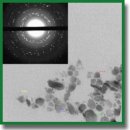
The Impact of Silicon Nanoparticle Porosity on Their Ability to Sensitize Low-Intensity Medical Ultrasound
This study investigates the role of porosity in silicon nanoparticles’ ability to act as sonosensitizers for sonodynamic therapy of malignant tumors.
Structural analysis showed that porous nanoparticles are composed of nanocrystals approximately 4 nm in size and contain 15 nm pores, whereas non-porous nanoparticles have a dense structure with nanocrystals ranging from 10 to 50 nm. Porous nanoparticles exhibit pronounced photoluminescent properties, associated with quantum confinement effects in their small nanocrystals.
The cytotoxicity of the nanoparticles was investigated in vitro using Hep2 cells. The results showed that both porous and non-porous nanoparticles in the studied concentration range (2–500 µg/ml) are non-toxic. Low-intensity ultrasound (0.88 MHz, <1 W) also does not have a toxic effect on the cells. However, the combined use of porous nanoparticles and ultrasound led to a significant decrease in cell viability, which was not observed when non-porous nanoparticles were used. This effect is associated with mechanical destruction of the cell membranes, as well as the potential activation of additional cell death mechanisms, such as apoptosis.
The results highlight the importance of porosity as a key factor determining the effectiveness of silicon nanoparticles as sonosensitizers. The high efficiency, low toxicity, and unique structural properties of porous nanoparticles make them a promising material for further research and development of targeted, non-invasive treatments for malignant tumors in the context of sonodynamic therapy.
- Osminkina L.A., Kudryavtsev A.A., Zinovyev S.V., Sviridov A.P., Kargina Y.V., Tamarov K.P., Nikiforov V.N., Ivanov A.V., Vasilyev A.N., Timoshenko V.Y. Silicon nanoparticles as amplifiers of the ultrasonic effect in sonodynamic therapy. Bull Exp Biol Med 2016; 161(2): 296–299, https://doi.org/10.1007/s10517-016-3399-x.
- Nikolaev A.L., Gopin A.V., Konopatskaya I.I., Mironov M.A., Pyatakov P.A., Andronova N.V., Treshchalina E.M., Dezhkunov N.V. Solid phase sonosensitization in sonodynamic therapy of cancer. Uchebnye zapiski fizicheskogo fakul’teta 2014; 5: 145344-1.
- Tachibana K., Feril L.B. Jr, Ikeda-Dantsuji Y. Sonodynamic therapy. Ultrasonics 2008; 48(4): 253–259, https://doi.org/10.1016/j.ultras.2008.02.003.
- Xu H., Zhang X., Han R., Yang P., Ma H., Song Y., Lu Z., Yin W., Wu X., Wang H. Nanoparticles in sonodynamic therapy: state of the art review. RSC Advances 2016; 6(56): 50697–50705, https://doi.org/10.1039/C6RA06862F.
- Huang Y., Ouyang W., Lai Z., Qiu G., Bu Z., Zhu X., Wang Q., Yu Y., Liu J. Nanotechnology-enabled sonodynamic therapy against malignant tumors. Nanoscale Adv 2024; 6(8): 1974–1991, https://doi.org/10.1039/d3na00738c.
- Park J.H., Gu L., von Maltzahn G., Ruoslahti E., Bhatia S.N., Sailor M.J. Biodegradable luminescent porous silicon nanoparticles for in vivo applications. Nat Mater 2009; 8(4): 331–336, https://doi.org/10.1038/nmat2398.
- Milliken S., Thiessen A.N., Cheong I.T., O'Connor K.M., Li Z., Hooper R.W., Robidillo C.J.T., Veinot J.G.C. "Turning the dials": controlling synthesis, structure, composition, and surface chemistry to tailor silicon nanoparticle properties. Nanoscale 2021; 13(39): 16379–16404, https://doi.org/10.1039/d1nr04701a.
- Heintz A.S., Fink M.J., Mitchell B.S. Silicon nanoparticles with chemically tailored surfaces. Applied Organometallic Chemistry 2010; 24(3): 236–240, https://doi.org/10.1002/aoc.1602.
- Maximchik P.V., Tamarov K., Sheval E.V., Tolstik E., Kirchberger-Tolstik T., Yang Z., Siakov V., Osminkina L.A. Biodegradable porous silicon nanocontainers as an effective drug carrier for regulation of the tumor cell death pathways. ACS Biomaterials Science & Engineering 2019; 5(11): 6063–6071, https://doi.org/10.1021/acsbiomaterials.9b01292.
- Gongalsky M.B., Tsurikova U.A., Kudryavtsev A.A., Pervushin N.V., Sviridov A.P., Kumeria T., Egoshina V.D., Tyurin-Kuzmin P.A., Naydov I.A., Gonchar K.A., Kopeina G.S., Andreev V.G., Zhivotovsky B., Osminkina L.A. Amphiphilic photoluminescent porous silicon nanoparticles as effective agents for ultrasound-amplified cancer therapy. ACS Appl Mater Interfaces 2025; 17(1): 374–385, https://doi.org/10.1021/acsami.4c15725.
- Sviridov A.P., Osminkina L.A., Nikolaev A.L., Kudryavtsev A.A., Vasiliev A.N., Timoshenko V.Y. Lowering of the cavitation threshold in aqueous suspensions of porous silicon nanoparticles for sonodynamic therapy applications. Applied Physics Letters 2015; 107(12), https://doi.org/10.1063/1.4931728.
- Osminkina L.A., Luckyanova E.N., Gongalsky M.B., Kudryavtsev A.A., Gaydarova A.Kh., Poltavtseva R.A., Kashkarov P.K., Timoshenko V.Y., Sukhikh G.T. Effects of nanostructurized silicon on proliferation of stem and cancer cell. Bull Exp Biol Med 2011; 151(1): 79–83, https://doi.org/10.1007/s10517-011-1264-5.
- Osminkina L.A., Nikolaev A.L., Sviridov A.P., Andronova N.V., Tamarov K.P., Gongalsky M.B., Kudryavtsev A.A., Treshalina H.M., Timoshenko V.Y. Porous silicon nanoparticles as efficient sensitizers for sonodynamic therapy of cancer. Microporous and Mesoporous Materials 2015; 210: 169–175, https://doi.org/10.1016/j.micromeso.2015.02.037.
- Osminkina L.A., Sivakov V.A., Mysov G.A., Georgobiani V.A., Natashina U.А., Talkenberg F., Solovyev V.V., Kudryavtsev A.A., Timoshenko V.Y. Nanoparticles prepared from porous silicon nanowires for bio-imaging and sonodynamic therapy. Nanoscale Res Lett 2014; 9(1): 463, https://doi.org/10.1186/1556-276X-9-463.
- Georgobiani V.A., Gonchar K.A., Osminkina L.A., Timoshenko V.Y. Structural and photoluminescent properties of nanowires formed by the metal-assisted chemical etching of monocrystalline silicon with different doping level. Semiconductors 2015; 49: 1025–1029, https://doi.org/10.1134/S1063782615080084.
- Shatskaia M.G., Nazarovskaia D.A., Gonchar K.A., Lomovskaya Y.V., Tsiniaikin I.I., Shalygina O.A., Kudryavtsev A.A., Osminkina L.A. Photoluminescent porous silicon nanowires as contrast agents for bioimaging. Kondensirovannye sredy i mezhfaznye granitsy 2024; 26(1): 161–167, https://doi.org/10.17308/kcmf.2024.26/11819.
- Canham L. Color of porous silicon. In: Canham L. (editor). Handbook of porous silicon. Springer, Cham; 2014, https://doi.org/10.1007/978-3-319-04508-5_27-1.










